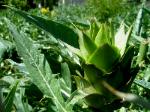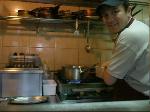Crete's Culinary Sanctuaries Spring Newsletter, 2010 by Nikki Rose |
www.cookingincrete.com
Copyright © 2008 Nikki Rose. All rights reserved. No portion of
this website can be copied without express written consent.
Copyright © 2008 Nikki Rose. All rights reserved. No portion of
this website can be copied without express written consent.
| Spring in Crete: Celebrating the International Year of Biodiversity It may seem as though there is no shortage of wild edible plants in Crete. Alas, that is not the case. During our spring seminars celebrating biodiversity, we had the chance to explore remote regions to enjoy a fantastic array of unique flora with the guidance of local teachers and scientists. We visited ancient sites that are not on the radar -- where the Minoans produced wine and olive oil 4,000 years ago. Within these semi-protected areas are some of Crete's rarest and most endangered flora. A hike along a gorge with fascinating geological formations led us to the south coast and a peaceful sanctuary in a quiet cove. The night sky was so brilliant with starlight it seemed surreal. "Scotty, do not beam me up!" There is no shortage of good food in Crete if you know where and when to look. That's been my mission for over 12 years and it's getting easier and harder, depending on the wrath of globalization and over-everything (over-development, over-fishing by giant illegal trawlers, etc). An increasing number of excellent organic farmers, vintners and creative chefs in Crete makes life delicious. A wild asparagus omelet with a crisp Vilana white wine is a fantastic combination. I thank these knowledgeable and dedicated people for suppling us with excellent food and wine and working to protect our cultural and natural heritage. Many of them will be featured in my upcoming book. Stay tuned. Our small-scale fishers also need much more support for their important work. But they manage to provide the lucky people in the know with incredible seafood, despite the obstacles. Travelers staying in huge resorts should note that it is not physically possible for fish to multiply to the degree needed to supply resort dining rooms. Guests are usually served farmed seafood from fairway lands. In between our adventures to historic and natural sites, we had the chance to meet fantastic food producers and enjoy wonderful meals together. Supporting local food providers is not just a good thing to do as a resident or visitor, the benefits are tremendous too. To discover the bigger picture of Cretan culture is to know musicians and artists that bring the magic of Crete to life with vibrant masterpieces. While we cannot share everything that we cherish with seminar attendees during their brief adventures with us on our magnificent island, a true taste can be memorably delicious. Kali Orexi! Nikki Rose and Crete's Culinary Sanctuaries Eco-Agritourism Network |
| Chill Out with CCS Fall 2010 Programs Join the CCS Network in Crete, Greece for our exciting small-group seminars. Next up: The Magnificent West: Wild Nature, Organic Food Production and Traditional Cuisine. September 27-October 2, 2010. Seminar details are on our Schedule Page Our summer schedule is hectic with private study tours for academic institutions. We try to respond to requests for private group seminars. If you have a small group of 8 - 20 people, contact us to discuss the possibilities of creating your own tailored seminar. Also check our schedule page for seminars that are open to the public. Note that aside from lodge owners and transportation providers we work with, the CCS network is not involved in the tourism industry and not always available to teach visitors, regardless of their profession. |
Fresh Green Bean and Zucchini Stew
Serves 4 people as a side dish or 2 people as a meal
Quite a few vegetable and bean stews in Crete begin with the same formula: Sauté aromatics, add vegetables
and a little stock or water and simmer until done. When you have vegetables straight from the garden, the flavors are
fantastic.
2 Tablespoons extra virgin olive oil
1 medium onion, chopped
4 cloves garlic, minced
1/2 teaspoon salt
3 medium zucchini, sliced on the bias about 1-inch thick
2 medium tomatoes, chopped
1/4 cup parsley, chopped
1 teaspoon dried oregano
black pepper to taste
1/2 cup chicken or vegetable stock or water
1 pound fresh green beans, strings removed
4 small potatoes, quartered and parboiled separately
In a medium-size heavy stockpot, sauté the onions and garlic in olive oil until just golden brown. Add the zucchini and sauté
3 minutes more. Add all remaining ingredients except the beans and bring to a gentle boil, stirring occasionally. Add the
beans, turn the heat down to medium-low and simmer, stirring occasionally until the vegetables are just tender -- about 10
minutes. Tastes great with whole grain bread and a little bit of good cheese. Note, I parboil the potatoes separately until
they are just barely done because I don't want to overcook the other vegetables, which take much less time and their great
individual flavors are lost by overcooking.
Pasta with Spring Vegetables
Serves 4 people as a side dish or 2 people as a meal
This is one of those impromptu dishes. When you think there is nothing in the house to eat -- grab pasta and add
whatever you have that tastes good with pasta. I basically had what I used in the vegetable stew recipe above. But on this
day, I also had artichokes and a prized variety of string bean with pink stripes. I used a special type of Cretan pasta that a
friend gave me -- a hand-rolled tubular pasta. But this recipe would work well with any type of medium-sized tubular pasta
like penne or cheese or vegetable ravioli.
For the Pasta and Vegetables:
1/2 pound pasta
2 medium artichokes, leaves and choke removed,
hearts with stems intact quartered
or 1 cup frozen small artichoke hearts
1 cup fresh or frozen peas
The Sauce:
2 Tablespoons extra virgin olive oil
1 small onion or 1 bunch scallions, chopped
6 cloves garlic, minced
1/2 teaspoon salt
2 large tomatoes, chopped
1/2 to 1/4 cup water from pasta stockpot (remember to reserve)
1/2 cup fresh parsley, chopped
1 teaspoon dried oregano
salt and pepper to taste
grated cheese
1. Prep the pasta stockpot. Add the fresh artichoke hearts and boil for 15 minutes.
2. Depending on what type of pasta you use, if it takes about 10 minutes to fully cook, add it to the artichokes after 15
minutes and continue, stirring frequently. Parboil the pasta to just barely done. Do not fully cook the pasta, as you will
continue to cook it later in the sauce.
3. Add the beans or peas just 3 minutes before the pasta will be ready. Drain, return to the stock pot. Toss together with a
little olive oil and set aside off the heat.
4. Meanwhile, in a medium sauté pan, sauté the onions and garlic in the olive oil with a little salt until just tender. Add the
remaining ingredients and bring to a gentle boil. Reduce the heat and simmer for 3 minutes. Add to the pasta with
vegetables. Bring it all to a simmer, gently stirring occasionally, until the pasta is cooked. Shake the pot but do not stir too
frequently, as that will create mush. If it looks as though it needs more moisture, add more water. Note: If the pasta I'm
using doesn't have much flavor, I use chicken or vegetable stock in place of pasta boiling water.
Thyme-Scented Roast Chicken and Carrots
Serves 4 to 6 people as part of a dinner that includes salads
I love the "place in oven and roast until done" recipe technique, particularly when I'm sitting on my butt in front of the
computer, trying to finish a spring newsletter before summer. When I have really wonderful ingredients, I don't want to mess
up a good thing, so I keep it very simple. I acquired a fresh organic chicken from a wonderful local farmer, some carrots and
a precious stash of wild thyme. My shopping adventures required exercise too, which was a bonus. Along with beautiful
golden organic olive oil that my friend, Chef Dimitris Maurakis, gave me, these priceless ingredients require great respect
and care.
One whole organic chicken (about 3 pounds)
8 medium carrots, peeled and cut on the bias about 1-inch
3 tablespoons extra virgin olive oil
2 teaspoons crushed dried thyme
salt and pepper to taste
1. Preheat oven to 400F.
2. Rub the chicken with olive oil and spices (reserve some for the carrots). Place chicken on a roasting pan rack if you have
one and tie the legs together with cotton twine. If you do not have a rack, make a bed of onions and carrots (roughly cut, no
need to peel) on a roasting pan to let air circulate under the bird while it is roasting.
3. Toss carrots with olive oil and spices and set aside.
4. Roast the chicken at 400F for 15 minutes. Reduce the temperature to 350F and continue cooking until golden brown and
cooked (about 20 minutes per pound). Baste occasionally with the pan juices.
5. 45 minutes before the chicken is done, add the carrots to the roasting pan in a single layer. Turn them occasionally but
let them caramelize (stick to the pan) without too much stirring.
6. Remove chicken from the oven and let it rest 10-15 minutes before carving. Or simply devour your favorite bits while
standing over the stove. Don't forget the oysters! Serve the pan juices separately if desired.
Serve with some greens and good wine if you like!
Recipe conversion charts from our fab Chef2Chef: http://www.chef2chef.net/recipes/recipe_index.php
Temperature conversion charts: http://www.onlineconversion.com/temperature.htm
Kali Orexi!
Nikki Rose
Copyright © Nikki Rose all rights reserved
|








